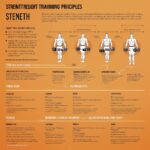
Incorporating strength training into a fitness regimen is imperative as it yields diverse physical and psychological advantages, extending beyond mere weightlifting. It’s not only for bodybuilders or professional athletes; everyone can gain from the structured application of resistance to muscles. By exploring this, I aim to shed light on its broader significance.
Some fear it leads to excessive bulkiness, while others dismiss its value beyond aesthetic muscle gains. I’m here to clarify that it’s neither exclusively for aestheticists nor solely about building size. Its advantages extend to enhancing functional strength, improving balance, and supporting mental health.
At the core of strength training are four fundamental principles: resistance, which challenges your muscles; intensity, difficulty level; volume, or the amount of work; and recovery, the essential downtime for your muscles to repair and strengthen.
Irrespective of one’s age or fitness level, strength training can enhance bone density, metabolic rate, and overall quality of life. It’s not a one-size-fits-all approach; it’s highly customizable to fit your needs and goals.
The Science of Muscular Adaptation: How Strength Training Works
When I lift weights, my muscles don’t just swell up magically. There’s a fascinating process behind the scenes called muscular adaptation. I want to explain this because grasping this concept differentiates a strategic lifter from a casual gym-goer.
Muscle hypertrophy, which means the growth of muscle cells, is one body’s response to strength training. When I subject my muscles to consistent overload – essentially doing more than they’re accustomed to – they adapt and grow in size and strength. Think of it as your body’s way of preparing to face that challenge better next time.
Neural adaptation is equally intriguing. It’s about efficiency. When I start strength training, my nervous system learns to recruit muscle fibers more effectively, leading to gains in strength before the size of the muscles even increases. So, it’s not just about getting bigger; it’s about getting more intelligent, neurologically speaking.
Here’s the phrase I emphasize: PROGRESSIVE OVERLOAD. I need to gradually increase the weight, frequency, or number of repetitions of my strength training routine for continuous improvement.
Let’s remember safety and efficacy, hinging on proper technique. Poor form isn’t just a shortcut to minimal gains; it’s a one-way ticket to Injury City.
How often and how long I should train might seem complex. But it boils down to a simple concept: balance. It is to participate in strength training routines focusing on the major muscle groups at least twice weekly. But my ideal schedule is unique, based on my goals, current fitness level, and recovery capacity.
By appreciating the science of how muscles respond and adapt to strength training, I’ve set a solid foundation. Next, I’m ready to craft a regimen that aligns with this understanding – one specific to my objectives. That’s where best practices come into play, and I’m keen to share those with you.
Designing Your Strength Training Regimen: Best Practices
Your goals are the compass that should guide your strength training program. Whether building muscle, increasing strength, enhancing endurance, or improving overall health, defining clear objectives is step one. Tailoring a workout plan to meet these goals ensures you’re on the right track.
When planning workouts, balance is critical. Start with compound exercises, which target multiple muscle groups at once. Examples include squats, deadlifts, and bench presses. Follow these with isolation exercises, which hone in on specific muscles, like bicep curls or leg extensions, to address particular areas of development.
It’s not just about what you do in the gym; it’s also about the time you spend recovering. Adequate rest periods between sets—and days of rest between workouts—are crucial for muscle repair and growth.
Variety isn’t merely the spice of life; it’s a cornerstone of practical strength training. Called periodization, altering your regimen every few weeks prevents plateaus. Vary your exercises, intensity, and volume to challenge your muscles continuously. Adjust these variables to fit your evolving fitness levels and to keep your routine fresh and engaging.
Nutrition and Lifestyle: The Foundations of Effective Strength Training
Some might think that strength gains are made solely through time lifting weights, but this is just part of the story. Adequate nutrition fuels your workouts and aids your body’s repair and growth processes. I’ll guide you through understanding how protein, carbs, and fats play different but vital roles in muscle recovery and how timing your meals can impact your strength and energy levels.
Hydration and quality sleep are the unsung heroes of strength training. Staying hydrated helps maintain peak performance, while a good night’s sleep is critical for muscle recovery. I’ll help you understand the nuances of your training regime’s seemingly mundane but crucial aspects.
Regarding supplements, I advocate a cautious approach. While they can support your training, they’re not a substitute for solid nutrition. I’ll advise which supplements have science behind them and how to integrate them responsibly into your fitness plan.
It’s essential to approach strength training with realistic expectations and a commitment to consistent effort. I will provide tips for maintaining smotivation and emotional readiness to stick with your strength training journey long-term. Remember, consistency is KING in strength training.
